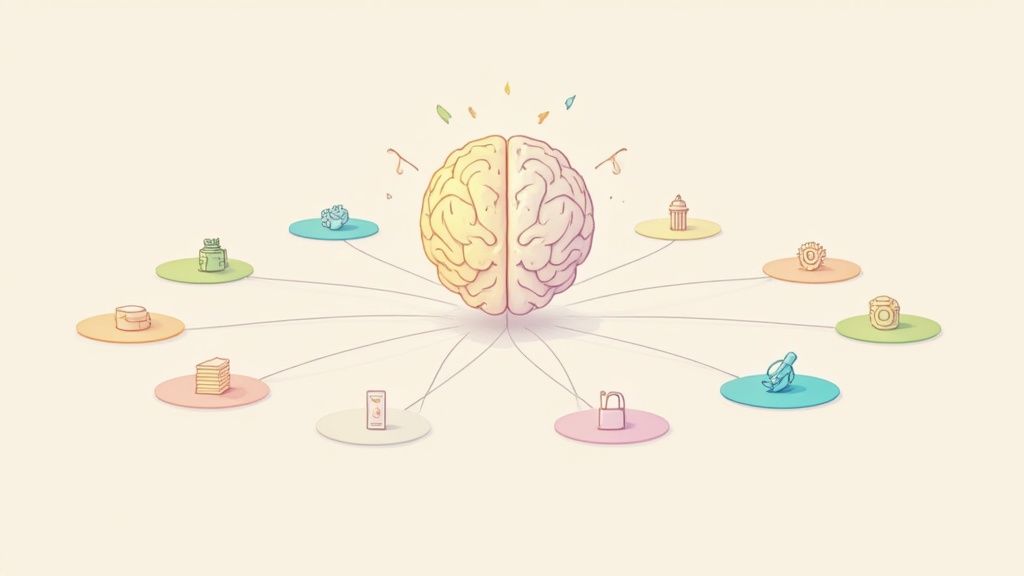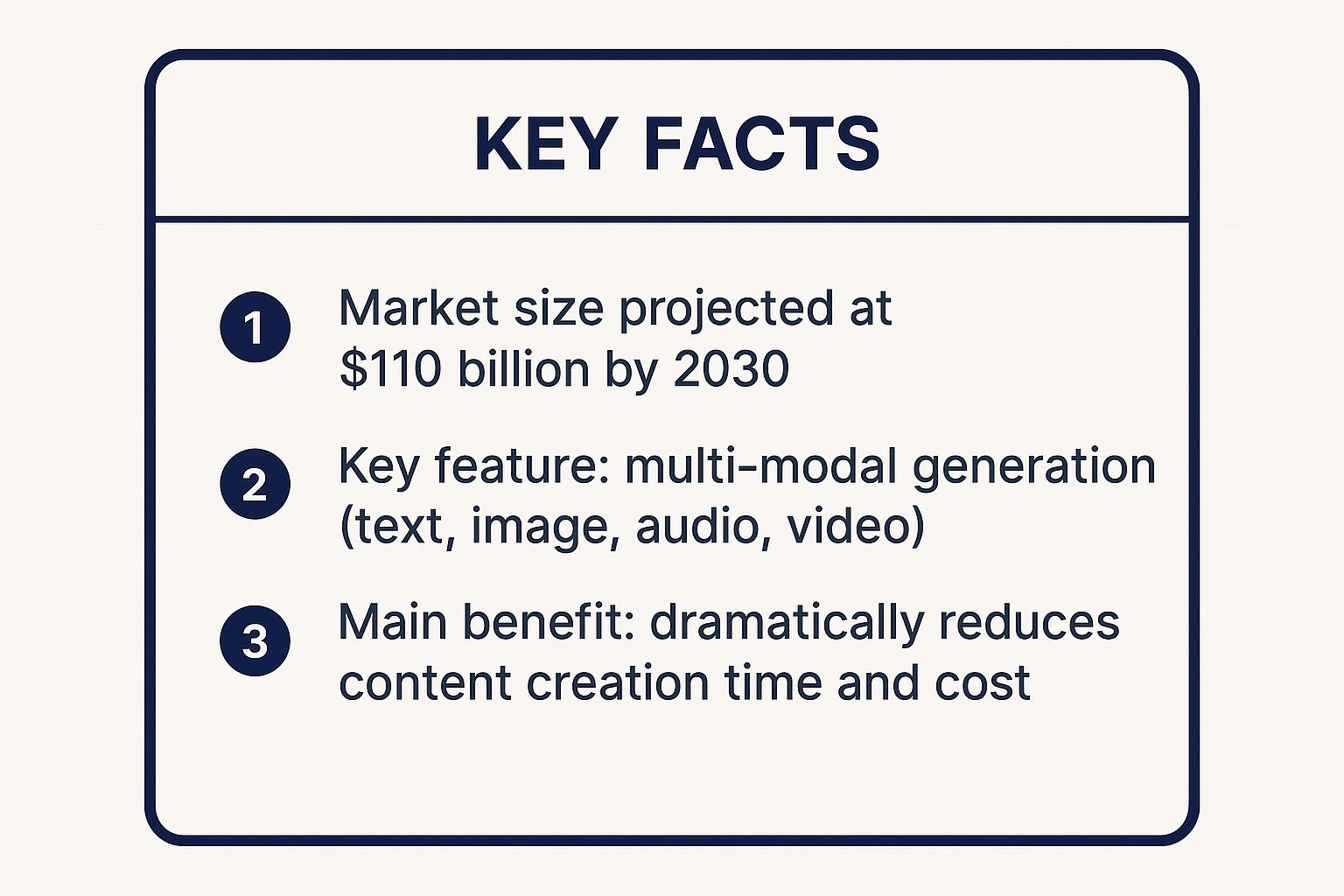
It feels like we are all swimming in an ocean of AI hype. Every day brings a new model, a new demo, a new claim that changes everything. I get it. The noise can be overwhelming. As an engineer building these systems for startups, I have seen the struggle firsthand: leaders want to leverage AI, but the path from a cool concept to a production grade feature is filled with potholes. We once had a client come to us with a grand vision for an AI system, only to realize after a few weeks of exploration that the real, immediate value was hiding in a much smaller, more focused application.
This list isn't about chasing trends. It's a pragmatic look at 10 areas where AI is genuinely creating value right now, with practical insights on how you can implement them. We will journey from the problem, explore the options, and land on a clear path you can follow. We will move past surface level conversations and into tangible strategies, covering everything from Generative AI and autonomous agents to the nuances of Explainable AI and Federated Learning. As we look beyond the current buzz, understanding deeper applications is crucial, including exploring how AI can help us be more creative. This collection is designed to be your field guide, helping you identify and build AI powered features that solve real problems and deliver measurable impact.
1. Generative AI for Content Creation
Generative AI is one of the most transformative artificial intelligence ideas for businesses today. This technology uses deep learning models, like transformers for text and diffusion models for images, to create entirely new content. By training on massive datasets, these models learn intricate patterns and can generate original text, images, video, music, and even code that mimics human creativity.
For startups and scale ups, this dramatically accelerates content pipelines that once took weeks. Imagine generating a month's worth of social media copy and corresponding visuals in a single afternoon. This isn't just theory; companies like Jasper and Midjourney are already enabling businesses to produce high quality marketing materials, product designs, and software prototypes at an unprecedented scale.
The infographic below summarizes the immense scale and core benefits of this technology.

The data clearly shows that Generative AI isn't a fleeting trend but a significant market opportunity, with its key value lying in multi modal generation and massive efficiency gains.
How to Implement Generative AI
Before we go deeper, here's what you should have in mind. To get started, focus on these actionable steps:
- Master Prompt Engineering: The quality of your output is directly tied to the quality of your input. Invest time in training your team on how to write clear, contextual, and detailed prompts.
- Establish a Human in the Loop: Use AI as a powerful first draft generator or a creative partner, not a complete replacement. Implement a mandatory human review process to ensure quality, accuracy, and brand alignment.
- Combine Tools for Better Workflows: Don't rely on a single tool. A powerful workflow might involve using a large language model to brainstorm ideas, a specialized tool to write copy, and an image generator for visuals.
- Stay Informed on Usage Rights: The legal landscape is evolving. To keep up with the shifting regulations and best practices, it's crucial to stay updated on the latest trends in AI content generation.
For even more advanced applications, you can enhance generative models with your company's private data. Explore how retrieval augmented generation can create smarter, context aware AI systems that are fine tuned to your specific business needs.
2. AI Powered Personalized Medicine
AI powered personalized medicine is one of the most impactful artificial intelligence ideas in healthcare. This approach uses machine learning algorithms to analyze vast datasets of individual patient information, including genetics, lifestyle, and medical history. By identifying subtle patterns within this data, AI models can help create highly tailored treatment plans, predict disease risks with greater accuracy, and optimize medication dosages for individual patient profiles. This marks a significant shift from traditional one size fits all approaches to a future of precision healthcare.
For startups in the MedTech space, this technology offers a chance to build powerful diagnostic and treatment recommendation tools. Companies like Tempus are already using AI to personalize cancer therapy by analyzing molecular and clinical data, while PathAI enhances diagnostic accuracy by applying machine learning to pathology. These applications are not just improving patient outcomes; they are fundamentally reshaping how we approach complex diseases by accounting for individual variability.

The ability to process and find correlations in complex multimodal health data is where AI truly excels, moving treatment from reactive to proactive.
How to Implement AI Powered Personalized Medicine
To build solutions in this space, focus on these critical steps:
- Ensure Robust Data Security: Patient data is highly sensitive. Prioritize compliance with regulations like HIPAA and GDPR from day one, implementing strong encryption, access controls, and data anonymization techniques.
- Start with Specific Pilot Programs: Avoid trying to solve everything at once. Begin with a focused pilot program in a specific disease area, such as oncology or rare genetic disorders, to validate your models and demonstrate value.
- Integrate with Existing Health Records: For your tool to be adopted, it must seamlessly integrate with Electronic Health Record (EHR) systems. Focus on creating APIs that allow for easy data flow between your platform and the systems clinicians already use.
- Establish Clear Clinical Protocols: AI should augment, not replace, clinical judgment. Develop clear protocols that define how healthcare professionals should use AI assisted recommendations in their decision making process, ensuring a human remains in the loop.
3. Autonomous AI Agents for Business Process Automation
Autonomous AI agents represent a major leap forward from simple task automation. These intelligent systems can independently perceive their environment, make decisions, and execute complex, multi step tasks without direct human intervention. Unlike traditional robotic process automation (RPA), which follows predefined rules, agents use reasoning and learning to handle dynamic situations, interact with software, and adapt their strategies based on outcomes.
For a startup, this unlocks powerful artificial intelligence ideas for optimizing operations. Imagine an agent that autonomously manages customer support tickets by understanding intent, querying a knowledge base, and drafting a response for human approval. Projects like AutoGPT and BabyAGI demonstrate this potential, while enterprise platforms from Microsoft and Salesforce are integrating agents directly into CRM and productivity workflows to automate sales outreach and data analysis.

This shift from rigid scripts to goal oriented action is what makes autonomous agents so transformative. They can tackle complex objectives, such as "research top competitors and summarize their Q3 marketing strategies," by breaking the goal down into executable steps.
How to Implement Autonomous AI Agents
To deploy agents effectively, start small and build trust in the system:
- Start with Well Defined Processes: Begin with low risk, high volume tasks that have clear success metrics, like data entry or initial lead qualification. This allows you to validate the agent's performance in a controlled environment.
- Implement Robust Monitoring: Create comprehensive logging and real time monitoring dashboards. You need full visibility into the agent's decisions, actions, and the tools it uses to debug issues quickly.
- Set Clear Boundaries and Guardrails: Program explicit constraints and approval requirements for critical actions. For instance, an agent might be able to draft an email but require human sign off before sending it.
- Maintain Human Oversight: Always keep a human in the loop for key decision points, especially for tasks involving customer interactions or financial transactions. Use agents to augment human capabilities, not replace them entirely.
4. AI Enhanced Cybersecurity and Threat Detection
AI enhanced cybersecurity is one of the most critical artificial intelligence ideas for protecting digital assets. This approach uses machine learning, neural networks, and behavioral analytics to proactively detect, prevent, and respond to cyber threats in real time. By analyzing massive volumes of network traffic and endpoint data, these systems identify anomalous patterns and predict potential attacks before they can cause significant damage.
For startups handling sensitive user data, this technology provides a necessary defense against sophisticated attacks that traditional rule based systems often miss. Companies like Darktrace and CrowdStrike leverage behavioral AI to create a dynamic understanding of a company's normal digital activity. When a deviation occurs, such as an unusual data exfiltration or a compromised account, the AI can autonomously neutralize the threat in seconds, minimizing the response time and potential impact.
How to Implement AI in Cybersecurity
To get started, focus on these actionable steps:
- Combine AI with Traditional Security: Use AI as a layer within a defense in depth strategy. It should augment, not replace, firewalls, endpoint protection, and encryption protocols.
- Update Models with Threat Intelligence: An AI's effectiveness depends on its training data. Continuously feed your models with the latest threat intelligence feeds and internal incident data to keep them sharp against new and evolving attack vectors.
- Implement Explainable AI (XAI): For security operations, it is crucial to understand why an AI system flagged an activity as malicious. XAI provides transparency into the model's decision making process, which is vital for forensic analysis and building trust with your security team.
- Maintain a Skilled Human Team: AI is a powerful partner, not a replacement for human expertise. Your security analysts are essential for managing the AI systems, interpreting complex alerts, and handling nuanced incidents that require human judgment. To better understand foundational concepts your team must master, you can explore how symmetric vs asymmetric keys work in modern encryption.
5. Edge AI and On Device Intelligence
Edge AI moves artificial intelligence ideas from the cloud directly onto local devices. Instead of sending data to a remote server for processing, AI models run on smartphones, IoT sensors, and vehicles. This approach leverages specialized hardware like Apple's Neural Engine or Google's Tensor chips to enable real time decision making with minimal latency, enhanced privacy, and offline functionality.
For startups, this opens doors to applications where speed and data security are non negotiable. Think of a smart security camera that analyzes video feeds on the device to detect threats instantly, without sending sensitive footage to the cloud. I once got stuck on a bug for hours where a device was lagging, only to realize we were sending way too much data to the cloud instead of processing it locally. It was a painful but valuable lesson in the power of edge computing. Companies like Tesla use this principle for their Full Self Driving computer, processing immense amounts of sensor data in real time to navigate safely. This on device intelligence is becoming a key differentiator for responsive and secure products.
How to Implement Edge AI
To bring AI processing to the device, focus on these critical steps:
- Use Model Compression: Raw AI models are often too large for edge devices. Use techniques like quantization (reducing numerical precision) and pruning (removing unnecessary model parameters) to create lightweight yet powerful models.
- Implement Hybrid Architectures: You don't have to choose between edge and cloud. Design systems where routine or time sensitive tasks are handled on the device, while more complex computations or model training sessions are offloaded to the cloud.
- Choose Specialized AI Chips: Whenever possible, leverage hardware built for AI. Processors like NVIDIA Jetson or Google Edge TPU provide optimized performance and power efficiency for running complex neural networks locally.
- Design for Graceful Degradation: Edge devices have finite resources. Plan for scenarios where the device's processing limits are reached, ensuring the application can degrade its functionality gracefully rather than crashing.
6. AI Driven Climate Modeling and Sustainability Solutions
Leveraging AI for climate modeling is one of the most critical artificial intelligence ideas with planet scale impact. This approach uses advanced machine learning to analyze vast and complex environmental datasets, including satellite imagery, oceanic sensor readings, and atmospheric variables. By identifying subtle patterns that traditional models might miss, AI creates more accurate climate predictions, forecasts extreme weather, and optimizes renewable energy infrastructure.
For businesses focused on sustainability, this technology provides powerful new tools. Companies like Google DeepMind, with its GraphCast model, are revolutionizing weather forecasting, while organizations such as Climate TRACE use AI to monitor global emissions with unprecedented accuracy. These systems transform raw data into actionable insights, enabling more effective resource management, verification of carbon credits, and the development of sustainable business practices. AI is accelerating our ability to understand and combat climate change.
How to Implement AI for Sustainability
To apply these concepts in your organization, focus on these key steps:
- Combine AI with Domain Expertise: AI models provide powerful predictions, but they must be grounded in climate science. Partner with environmental scientists and meteorologists to validate, calibrate, and interpret the outputs of your models.
- Prioritize Explainable AI (XAI): Climate and sustainability decisions carry significant weight. Use XAI techniques to make your models transparent and build trust with stakeholders, ensuring that predictions are understandable and defensible.
- Optimize for Efficiency: Training large AI models can be energy intensive. Focus on creating computationally efficient models to minimize their own carbon footprint, ensuring your solution is part of the answer, not the problem.
- Focus on Actionable Insights: A highly accurate prediction is only useful if it drives a decision. Design your systems to produce clear, actionable insights that can directly inform sustainability strategies, optimize energy grids, or improve supply chain efficiency.
7. Multimodal AI Systems
Multimodal AI systems represent a significant leap forward in artificial intelligence ideas, moving beyond single data type processing. These systems can simultaneously understand and generate content across multiple formats like text, images, audio, and video. By integrating these different inputs, the AI develops a richer, more contextual understanding of information, much like how humans use multiple senses to perceive the world around them.
This capability unlocks far more sophisticated applications than unimodal systems. Imagine an AI that can watch a product demonstration video, listen to the presenter's explanation, and generate a detailed technical summary with illustrative diagrams. Companies like OpenAI with GPT 4V and Google with Gemini are at the forefront, creating models that can reason across visual and linguistic information seamlessly. This creates opportunities for more intuitive user interfaces, deeper data analysis, and more accessible technology.
How to Implement Multimodal AI
Let us pause and reflect. Harnessing this powerful technology can be complex, so consider these implementation steps:
- Start with a Defined Use Case: Before attempting to integrate every possible data type, pinpoint a specific business problem that benefits from combining two or three modalities. For example, a customer support tool could analyze both the text of a complaint and an image of a faulty product.
- Implement Modality Specific Preprocessing: Each data type (text, image, audio) requires its own specialized preprocessing pipeline to clean, format, and convert it into a state the model can understand. This is a critical first step for quality results.
- Leverage Attention Mechanisms: Use attention mechanisms within your model architecture. This allows the AI to dynamically weigh the importance of different modalities when making a decision or generating an output, focusing on the most relevant information.
- Ensure Balanced Training Data: When training or fine tuning a multimodal model, it is crucial to have a dataset where all modalities are well represented. An imbalance can lead to the model over relying on one data type and ignoring others.
8. AI Powered Drug Discovery and Molecular Design
AI powered drug discovery represents one of the most high impact artificial intelligence ideas, leveraging sophisticated models to dramatically reshape pharmaceutical research. This approach uses deep learning and generative models to identify and design new therapeutic compounds. By analyzing vast biological and chemical datasets, these systems can predict molecular properties, simulate complex drug target interactions, and generate novel chemical structures with desired therapeutic effects.
For biotech startups and established pharmaceutical companies, this technology drastically cuts down the traditional 10 to 15 year drug development timeline and its associated billions in costs. Instead of slow, manual screening, AI can digitally evaluate billions of potential molecules in days. Companies like Insilico Medicine are already bringing AI discovered drugs to human clinical trials, while DeepMind's AlphaFold has fundamentally solved the protein structure prediction problem, accelerating research worldwide.
This shift from manual lab work to computational design allows for the exploration of chemical spaces that were previously unreachable, promising faster breakthroughs for a wide range of diseases.
How to Implement AI in Drug Discovery
To integrate this technology, focus on these foundational steps:
- Invest in High Quality Datasets: The performance of any model is contingent on the data it's trained on. Focus on acquiring and curating high quality, structured datasets covering genomics, proteomics, and chemical compound libraries.
- Focus on a Niche: Instead of tackling all diseases, concentrate on a specific disease area or a particular class of protein targets. This focus allows for more specialized models and deeper domain expertise.
- Combine AI with Human Expertise: AI models are powerful for generating hypotheses and identifying candidates, but they are not a replacement for human experts. Collaborate closely with medicinal chemists and biologists to validate predictions and guide the discovery process.
- Use Interpretable Models: Whenever possible, use models that offer interpretability. Understanding why a model made a certain prediction is crucial for building trust, debugging issues, and gaining novel scientific insights from the system's outputs.
9. Explainable AI (XAI) and Interpretable Machine Learning
As AI systems become more integrated into critical decision making processes, the "black box" problem becomes a significant barrier to trust and adoption. Explainable AI, or XAI, is one of the most vital artificial intelligence ideas for addressing this challenge. It focuses on developing models and techniques that can provide clear, understandable explanations for their outputs, moving beyond simple predictions to offer insight into their reasoning.
For startups deploying AI in high stakes fields like finance, healthcare, or legal tech, explainability is not just a feature; it's a requirement for regulatory compliance and user trust. Imagine a model that denies a loan application or suggests a medical diagnosis. Without XAI, you cannot audit its decision, check for bias, or justify the outcome to a customer. Tools like SHAP (SHapley Additive exPlanations) and LIME (Local Interpretable Model agnostic Explanations) allow developers to attribute a model's prediction to specific input features, making its logic transparent.
How to Implement Explainable AI
To begin building more transparent systems, concentrate on these actionable steps:
- Start with Interpretable Models: Whenever possible, consider using inherently transparent models like linear regression, decision trees, or generalized additive models for tasks where explainability is paramount. Their simple structure makes their decision logic easy to follow.
- Apply Post Hoc Explanation Techniques: For more complex, black box models like deep neural networks, use post hoc methods like SHAP or LIME. These tools analyze the model's behavior to provide feature importance scores and local explanations for individual predictions.
- Validate Explanations with Domain Experts: An explanation is only useful if it makes sense to the end user. Work directly with domain experts to ensure that the AI's reasoning aligns with their knowledge and expectations, helping to catch flawed logic early.
- Document Model Limitations: Transparency includes being honest about what your model cannot do. Clearly document the model's performance boundaries, potential biases identified during testing, and the level of uncertainty in its explanations.
10. Federated Learning and Privacy Preserving AI
Federated learning is one of the most critical artificial intelligence ideas for businesses navigating a privacy conscious world. This distributed machine learning approach trains models across multiple decentralized devices, like smartphones or local servers, without ever centralizing the raw data. Instead of moving sensitive user data to a server, the model is sent to the data, trained locally, and only the resulting model updates are aggregated.
For startups handling sensitive user information, this paradigm shift is a game changer. It allows for collaborative AI development while inherently protecting user privacy and ensuring compliance with regulations like GDPR. Companies like Apple use this technique for Siri and keyboard predictions, improving their services without accessing personal photos or messages. This approach builds user trust while still leveraging collective data insights.
This method effectively decouples model training from the need for direct access to sensitive data, making it invaluable for industries like healthcare and finance.
How to Implement Federated Learning
To get started with this privacy first approach, focus on these actionable steps:
- Start with Trusted Participants: Before scaling, pilot your federated learning system within a small, trusted network of participants. This controlled environment allows you to refine your aggregation protocols and identify potential security vulnerabilities safely.
- Implement Differential Privacy: Enhance protection by adding mathematical noise to the model updates shared by each device. This makes it virtually impossible to reverse engineer the updates to infer information about any single individual's data.
- Use Secure Aggregation: Employ cryptographic protocols that allow a central server to compute the sum of model updates from various devices without being able to see any individual update. This prevents data leakage even from a compromised server.
- Address Data Heterogeneity: Data on user devices is often non IID (not independent and identically distributed). Use personalization techniques, such as creating a hybrid model with both global and local components, to ensure the final model performs well for all users.
- Monitor for Anomalous Updates: Implement robust monitoring to detect and filter out unusual model updates that could indicate a poisoning attack, where a malicious actor attempts to compromise the global model.
As quantum computing advances, the need for such privacy preserving techniques will only grow. Learn more about how the future of computing could reshape digital privacy and the importance of proactive security measures.
Top 10 AI Ideas Comparison Matrix
| AI Technology | Implementation Complexity | Resource Requirements | Expected Outcomes | Ideal Use Cases | Key Advantages |
|---|---|---|---|---|---|
| Generative AI for Content Creation | Moderate to High | High computational power, large datasets | Rapid, scalable creation of multi modal content | Creative industries, marketing, prototyping | Reduces creation time/costs, enables personalization |
| AI Powered Personalized Medicine | High | Extensive healthcare data and secure infra | Tailored treatments, improved diagnostics | Healthcare, clinical decision support | Improves outcomes, early detection, cost reduction |
| Autonomous AI Agents for Business Automation | High | Complex integration, continuous monitoring | Autonomous task execution and workflow automation | Knowledge work automation, enterprise workflows | Handles complex tasks, operates 24/7, self improves |
| AI Enhanced Cybersecurity and Threat Detection | High | Large datasets, high infra and compute | Faster threat detection, automated incident response | Network security, real time threat monitoring | Scales security, reduces false positives, adapts |
| Edge AI and On Device Intelligence | Moderate | Specialized hardware, resource constrained devices | Real time inference with low latency and privacy | IoT devices, autonomous vehicles, offline AI | Low latency, enhanced privacy, reduced bandwidth |
| AI Driven Climate Modeling and Sustainability | High | Massive compute, large diverse datasets | Improved climate predictions, sustainability insights | Environmental monitoring, renewable energy | Enhances prediction accuracy, enables proactive response |
| Multimodal AI Systems | Very High | Extensive multi modal datasets and compute | Richer understanding, versatile input/output handling | Complex AI applications needing multi sensory input | Comprehensive context, better reasoning, accessibility |
| AI Powered Drug Discovery and Molecular Design | High | High compute and specialized biological data | Accelerated drug design and discovery | Pharmaceutical research, rare diseases | Reduces cost/time, explores novel chemical space |
| Explainable AI (XAI) and Interpretable ML | Moderate to High | Additional compute for interpretation | Transparent, trustable AI decisions | Regulated industries, high stakes decision making | Builds trust, aids debugging, meets regulatory needs |
| Federated Learning and Privacy Preserving AI | High | Distributed infrastructure, secure protocols | Collaborative training without data sharing | Privacy sensitive domains, healthcare, finance | Preserves privacy, reduces data transfer, enables compliance |
Your Next Move: From Idea to Implementation
We have journeyed through a landscape of powerful artificial intelligence ideas, from generative AI that crafts compelling content to federated learning systems that safeguard user privacy. This exploration reveals a crucial truth: the most impactful AI is not born from technology for its own sake. It emerges from a deep understanding of a specific, tangible problem, whether that is accelerating drug discovery, automating tedious business processes, or securing digital infrastructure.
The ideas presented here, spanning from multimodal systems to explainable AI, are not just abstract concepts. They are blueprints for innovation, each offering a unique lens through which to view your own challenges. The true value lies in connecting these advanced capabilities back to the human or business needs at the core of your mission.
From Blueprint to Build: Your Action Plan
So, where do you go from here? The path from a promising idea to a production grade application requires a blend of strategic vision and technical precision. Before you commit to a single direction, take a moment to distill the insights from this article into actionable steps.
- Revisit Your Core Problem: Which of these ten domains directly addresses the most significant pain point for your users or your internal teams? Is it a bottleneck in content creation, a gap in cybersecurity, or an opportunity to deliver hyper personalized experiences? Let the problem, not the technology, guide your first move.
- Identify the Minimum Viable AI: You do not need to build a fully autonomous, all knowing system from day one. What is the smallest, most valuable feature you can ship? For example, instead of a full generative AI suite, could you start with a simple AI powered headline generator? Instead of a complete XAI dashboard, could you begin by providing feature importance scores for a single critical model?
- Assess Your Data and Infrastructure: Every AI idea has prerequisites. Do you have the necessary data for a multimodal system? Is your infrastructure ready for the demands of edge AI? A realistic audit of your current capabilities will prevent false starts and help you choose a project that is ambitious yet achievable.
Key Takeaways
- Start with a Problem, Not a Technology: The most successful AI applications solve a real, specific user or business need.
- Build Incrementally: Begin with a Minimum Viable AI to deliver value quickly and learn from user feedback before scaling up complexity.
- Human Oversight is Non Negotiable: Whether it's for content review, cybersecurity decisions, or medical diagnostics, keep a human in the loop to ensure quality, safety, and accountability.
- Prioritize Trust and Privacy: In an increasingly data conscious world, technologies like XAI and Federated Learning are not just features but foundational requirements for user adoption.
The journey of building with AI is one of constant learning and adaptation. The field moves at an incredible pace, but the fundamental principles of good engineering and product development remain constant. The artificial intelligence ideas we have discussed are more than just items on a list; they are invitations to build the future. By moving from broad concepts to a focused implementation plan, you transform potential into tangible value. The most exciting part is not just imagining what is possible but taking the deliberate, informed steps to make it a reality.
Navigating the complexities of AI implementation, from architecture design to scaling in production, requires seasoned expertise. If you are ready to transform these artificial intelligence ideas into robust, scalable software, consider partnering with a specialist who has been there before. As a dedicated consultant and architect, Kuldeep Pisda helps startups and scale ups build production grade AI systems. Let us connect and map out the technical strategy to bring your vision to life. You can learn more at Kuldeep Pisda.
Become a subscriber receive the latest updates in your inbox.



Member discussion